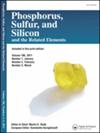A promising α-amylase inhibitor based on the 2-(2-hydrazinyl) thiazole scaffolds: synthesis, docking studies and biological evaluation
IF 1.4
4区 化学
Q4 CHEMISTRY, INORGANIC & NUCLEAR
Phosphorus, Sulfur, and Silicon and the Related Elements
Pub Date : 2024-09-02
DOI:10.1080/10426507.2024.2424274
引用次数: 0
Abstract
A series of novel hydrazinyl-based thiazole scaffolds were designed, synthesized, and evaluated for their anti-diabetic activity. The cyclocondensation reaction of the appropriately substituted acetophenones 1, thiosemicarbazide 2, and appropriate phenacyl bromide 3 allowed for the creation of a new series of hydrazinyl-based thiazole scaffolds (4a–h). The newly generated compounds were characterized using mass spectrometry,1H NMR, IR, and 13C NMR techniques. The novel hydrazinyl-based thiazole scaffolds were evaluated by the in vitro α-amylase inhibitory assay. Hydrazinyl-based thiazole scaffolds 4a, 4b, 4d, and 4f showed good activity compared to acarbose as a standard reference. Although insulin is a necessary medication for the treatment of diabetes, it carries a significant risk. We believe that thiazole scaffolds based on hydrazinyl structural motive provide recommendations for designing and producing novel anti-diabetic drugs, which are critically needed. Moreover, these compounds show a strong affinity for the pancreatic α-amylase protein binding site, suggesting greater inhibitory capability at the cellular level, and molecular docking studies have demonstrated their better-fit potential as anti-diabetic agents. This indicates the versatility of the hydrazinyl-based thiazole molecules to achieve new classes of anti-diabetic scaffold.
基于2-(2-肼基)噻唑支架的α-淀粉酶抑制剂:合成、对接研究及生物学评价
设计、合成了一系列新型肼基噻唑支架,并对其抗糖尿病活性进行了评价。适当取代的苯乙酮1、硫代氨基脲2和适当的苯那基溴3的环缩合反应允许创建一系列新的肼基噻唑支架(4a-h)。利用质谱、1H NMR、IR和13C NMR技术对新生成的化合物进行了表征。采用体外α-淀粉酶抑制实验对新型肼基噻唑支架进行评价。以肼基为基础的噻唑类支架4a、4b、4d和4f与阿卡波糖作为标准参比具有良好的活性。虽然胰岛素是治疗糖尿病的必要药物,但它也有很大的风险。我们认为基于肼基结构动机的噻唑支架为设计和生产新型抗糖尿病药物提供了建议,这是迫切需要的。此外,这些化合物对胰腺α-淀粉酶蛋白结合位点具有很强的亲和力,表明在细胞水平上具有更强的抑制能力,分子对接研究表明它们更适合作为抗糖尿病药物。这表明以肼基为基础的噻唑分子的多功能性可以实现新型的抗糖尿病支架。
本文章由计算机程序翻译,如有差异,请以英文原文为准。
求助全文
约1分钟内获得全文
求助全文
来源期刊
CiteScore
2.60
自引率
7.70%
发文量
103
审稿时长
2.1 months
期刊介绍:
Phosphorus, Sulfur, and Silicon and the Related Elements is a monthly publication intended to disseminate current trends and novel methods to those working in the broad and interdisciplinary field of heteroatom chemistry.

 求助内容:
求助内容: 应助结果提醒方式:
应助结果提醒方式:


